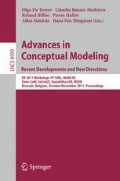Abstract
The advent of multi-core processors offers an opportunity to increase the usage of Executable UML. Researchers are advocating the division of software systems into a productivity layer and an efficiency layer to shield mainstream programmers from the complexities of parallelism. Such separation of application and platform concerns is the foundation of Executable UML. To leverage this opportunity, an approach to Executable UML must address the complexity of the UML standard and provide a formal model of concurrency. In this paper, we introduce the Actor-eUML model and formalize the mapping between actors in the Actor model and Executable UML agents (active objects) by unifying the semantics of actor behavior and the hierarchical state machine (HSM) semantics of Executable UML agents. The UML treatment of concurrency is simplified, and the Actor model is extended to enable a set of actor behaviors to specify the HSM for an Executable UML active class.
Access this chapter
Tax calculation will be finalised at checkout
Purchases are for personal use only
Preview
Unable to display preview. Download preview PDF.
References
Agha, G.: Actors: A Model of Concurrent Computation in Distributed Systems. MIT Press, Cambridge (1986)
Agha, G., Mason, I.A., Smith, S.F., Talcott, C.L.: A Foundation for Actor Computation. Journal of Functional Programming, 1–72 (1997)
Harel, D.: Statecharts: A Visual Formalism for Complex Systems. Science of Computer Programming 8(3), 231–274 (1987)
Mellor, S.J., Balcer, S.J.: Executable UML: A Foundation for Model-Driven Architecture. Addison-Wesley, Reading (2002)
Mellor, S.J., Kendall, S., Uhl, A., Weise, D.: MDA Distilled. Addison-Wesley, Reading (2004)
Milicev, D.: Model-Driven Development with Executable UML. Wiley, Chichester (2009)
Patterson, D., et al.: A View of the Parallel Computing Landscape. Communications of the ACM 52(10), 56–67 (2009)
Patterson, D.: The Trouble with Multi-Core. IEEE Spectrum 47(7), 28–32 (2010)
Raistrick, C., Francis, P., Wright, J., Carter, C., Wilkie, I.: Model Driven Architecture with Executable UML. Cambridge University Press, Cambridge (2004)
Tomlinson, C., Singh, V.: Inheritance and Synchronization with Enabled Sets. SIGPLAN Notices 24(10), 103–112 (1989)
Object Management Group: UML Superstructure Specification, Version 2.1.2, http://www.omg.org/docs/formal/07-11-02.pdf
Object Management Group: Semantics of a Foundational Subset for Executable UML Models (fUML), Version 1.0, http://www.omg.org/spec/FUML
Author information
Authors and Affiliations
Editor information
Editors and Affiliations
Rights and permissions
Copyright information
© 2011 Springer-Verlag Berlin Heidelberg
About this paper
Cite this paper
Marth, K., Ren, S. (2011). Actor-eUML for Concurrent Programming. In: De Troyer, O., Bauzer Medeiros, C., Billen, R., Hallot, P., Simitsis, A., Van Mingroot, H. (eds) Advances in Conceptual Modeling. Recent Developments and New Directions. ER 2011. Lecture Notes in Computer Science, vol 6999. Springer, Berlin, Heidelberg. https://doi.org/10.1007/978-3-642-24574-9_39
Download citation
DOI: https://doi.org/10.1007/978-3-642-24574-9_39
Publisher Name: Springer, Berlin, Heidelberg
Print ISBN: 978-3-642-24573-2
Online ISBN: 978-3-642-24574-9
eBook Packages: Computer ScienceComputer Science (R0)

